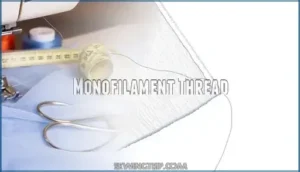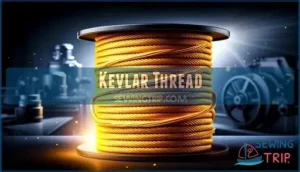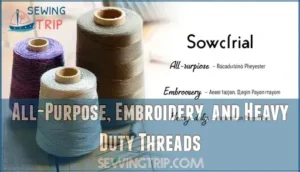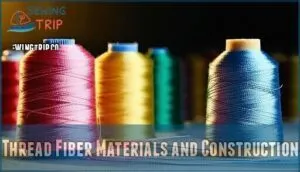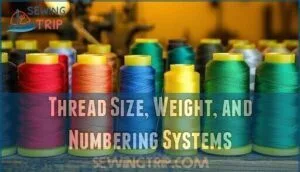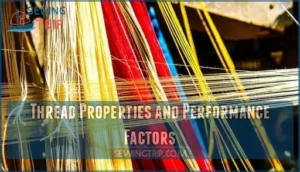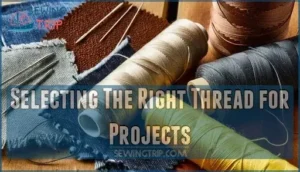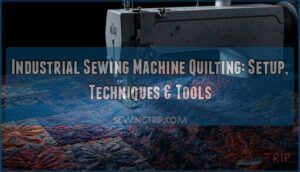This site is supported by our readers. We may earn a commission, at no cost to you, if you purchase through links.
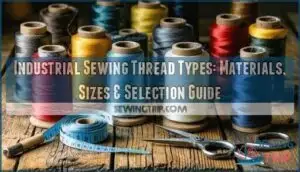 Pick the wrong thread for an industrial sewing project and you’ll watch seams fail under stress, needles snap mid-run, or fabric pucker beyond repair. The difference between a garment that lasts years and one that falls apart in months often comes down to matching thread properties—tensile strength, fiber construction, size—to the specific demands of your application.
Pick the wrong thread for an industrial sewing project and you’ll watch seams fail under stress, needles snap mid-run, or fabric pucker beyond repair. The difference between a garment that lasts years and one that falls apart in months often comes down to matching thread properties—tensile strength, fiber construction, size—to the specific demands of your application.
Whether you’re reinforcing automotive upholstery or stitching sailcloth that’ll face UV bombardment and constant flexing, understanding industrial sewing thread types transforms guesswork into precision. This guide breaks down the materials, measurements, and performance factors that separate hobby-grade spools from threads engineered to survive punishing industrial conditions.
Table Of Contents
Key Takeaways
- Matching thread properties—tensile strength, fiber type, construction method, and size—to your specific fabric and stress conditions prevents seam failure, needle breakage, and premature wear far more effectively than guessing based on appearance alone.
- Thread numbering systems (Tex, Denier, ticket numbers) measure thickness differently, but higher Tex or Denier values always indicate heavier thread, while lower weight numbers (40 wt vs. 50 wt) counterintuitively mean thicker thread.
- Bonded nylon excels in abrasion resistance and heavy-duty applications like automotive upholstery and outdoor gear, while spun polyester offers cost-effective versatility across natural and synthetic fabrics with a cotton-like feel.
- Environmental factors like humidity, UV exposure, and chemical contact degrade thread performance over time, making proper storage conditions and finish selection (anti-wick, bonded, UV-resistant) critical for maintaining seam integrity in demanding applications.
Key Industrial Sewing Thread Types
When you’re working on industrial projects, choosing the right thread isn’t just about what’s on the spool—it’s about matching the material to the job at hand. Different thread types offer unique properties, from strength and stretch to abrasion resistance and durability.
Let’s look at the most common industrial thread options and what makes each one stand out.
Spun Polyester Thread
Spun polyester thread is the workhorse of industrial sewing, offering a cotton-like feel with durability that’s second to none. This thread combines polyester’s strength with a soft hand, making it ideal for general-purpose sewing across countless applications.
Key characteristics of spun polyester:
- Adaptable performance – Works well with both natural and synthetic fabrics, adapting to diverse thread applications in garment construction and industrial projects
- Excellent dyeing process – Accepts color consistently, producing vibrant, long-lasting hues that resist fading
- Cost-effective choice – Delivers strong thread properties at a lower price point than specialty threads, making it practical for high-volume production
- Blended thread option – Can be combined with cotton or other fibers to improve specific polyester properties while maintaining industrial sewing thread standards
- Minimal stretch – Provides stable seams without excessive elongation, ensuring reliable thread selection for structural applications
You’ll find this polyester thread type balances affordability with performance. The global market shows growth driven by apparel production.
Bonded Nylon Thread
When you need thread that can take a beating, bonded nylon steps up. This industrial sewing thread features continuous nylon filaments coated with resin—a bonding technology that fuses fibers, reduces fraying, and delivers superb abrasion resistance. Size 92 breaks at around 15–19 lbs, making it ideal for leather goods, automotive upholstery, and outdoor gear.
Industrial applications demand machine compatibility with walking foot or compound feed equipment, since standard home machines can’t work with these heavy thread sizes. Market trends show strong growth as manufacturers prioritize thread properties like chemical resistance and minimal lint in high-speed production.
For example, it’s frequently used in military and tactical gear due to its durability.
Monofilament Thread
If hiding your stitches matters—think clear bra straps, invisible hems, or quilting—monofilament thread does the job without announcing itself. This single-strand nylon or polyester filament offers thread transparency few others can match, though you’ll trade off some knot strength for that invisibility—it stretches 31% on average.
Here’s what you should know:
- Best uses: Invisible stitches in garment alterations, appliqué, and decorative topstitching where thread color matching is difficult
- Monofilament properties: Low lint, smooth surface, moderate tensile strength suited for light- to medium-weight fabrics
- Industrial applications: Automated quilting lines and high-speed bag closures where stitch appearance must stay discreet
Choose monofilament thread when your project demands stealth over raw strength.
Kevlar Thread
When stealth won’t cut it, Kevlar thread steps up. This aramid fiber brings tensile strength near 3,000 MPa—five times stronger than steel by weight—with only 2% stretch before breaking.
You’ll find Kevlar applications across bulletproof vests, aerospace components, and tire reinforcement, where thermal resistance up to 450°C and minimal creep matter.
Market growth reflects rising demand: the global Kevlar thread market hit $500 million in 2024 and projects $800 million by 2033. Just watch for chemical degradation in strong acids.
All-Purpose, Embroidery, and Heavy Duty Threads
Three thread workhorses manage most of your sewing lineup—all-purpose for everyday seams, embroidery for decorative stitching, and heavy duty when fabric weight demands it.
Thread applications break down by stitch compatibility:
- All-purpose thread (polyester or cotton) suits general seams, edge stitching, and construction work where moderate strength meets daily wear.
- Embroidery thread (rayon, polyester, silk) delivers vibrant colors for decorative machine or hand stitching with excellent sheen.
- Heavy duty thread withstands high stress on upholstery, canvas, and thick materials where standard threads fail.
Project suitability and performance comparison guide your choice—match thread strength to fabric weight.
Thread Fiber Materials and Construction
The material you choose and how it’s constructed will determine how well your thread performs under real-world conditions. Different fibers bring different strengths to the table, from cotton’s softness to nylon’s stretch resistance.
Let’s look at the main fiber types and construction methods that shape industrial thread performance.
Cotton, Polyester, Nylon, Rayon, and Silk Threads
Cotton Thread is soft and ideal for natural fabrics but lacks the durability of synthetics. Rayon Thread provides decorative appeal but weakens when wet, limiting material applications.
Polyester Thread dominates industrial applications due to higher thread durability, UV resistance, and cost-effectiveness. Nylon Thread offers remarkable tensile strength and elasticity for heavy-duty sewing performance.
Silk delivers peerless fineness and flexibility, though cost considerations usually restrict it to specialty projects requiring premium fiber properties.
Metallic, Glitter, and Mylar Threads
Decorative threads transform ordinary stitching into eye-catching design elements, though their material composition presents unique challenges. Metallic thread types like Mylar thread and glitter thread introduce shimmer through thin metal-wrapped filaments, requiring adjusted sewing techniques.
These industrial thread types demand specialized needle selection and reduced machine tension to prevent breakage during production runs.
- Thread luster intensifies under lighting but compromises tensile strength
- Durability concerns arise from brittleness during high-speed industrial operations
- Design applications favor embroidery over structural seams
- Material composition blends polyester cores with reflective coatings for visual appeal
Thread Construction Methods (Spun, Core-Spun, Filament)
The way threads get built—whether spun from short fibers, wrapped around a core, or drawn as continuous filaments—determines everything from how smoothly they feed through your machine to whether your seams hold up under stress.
Spun thread offers flexibility and a cotton-like feel, while core-spun construction pairs hybrid thread tech with greater strength by wrapping fibers around a filament core.
Filament threads deliver consistent tension and minimal lint, making construction method comparison essential for matching your application’s demands.
Thread Processing and Finishes
Once your thread leaves the factory floor, it’s the finish that decides whether it’ll survive UV exposure, resist water intrusion, or glide through industrial machines without gumming up needles.
Anti-wick finishes repel moisture to prevent weeping seams, while bonded finishes seal nylon and polyester with a protective casing. Gassed finishes reduce lint buildup, mercerized finishes boost strength and luster, and glazed finishes create smooth feeding—though they require regular machine cleaning to prevent residue.
Thread Size, Weight, and Numbering Systems
Understanding thread size might feel like cracking a code, but it’s simpler than you think. Different numbering systems measure the same thing—just from different angles.
Let’s break down the three main systems you’ll encounter and how to use them in real-world projects.
Tex, Denier, and Ticket Number Explained
You might wonder why threads carry multiple numbers on their spools. Tex measurements express the weight in grams per 1,000 meters of thread, while Denier differences show weight per 9,000 meters. Higher Tex or Denier numbers mean thicker thread.
Manufacturers also use Ticket conversion numbers for sizing, though ticket numbering systems vary by brand, making direct comparisons tricky without understanding these thread size and measurement standards.
Thread Weight and Thickness
Picking the right weight means balancing thread thickness with fabric strength—smaller weight numbers indicate heavier threads that withstand more stress, while higher numbers point to finer threads suited for delicate work. Thread measurement tools and weight conversion charts help you match fabric thickness properly.
- Tex size runs from 15 (lightweight) to 415 (heavy-duty industrial)
- Thread thickness affects stitch visibility and seam durability
- Specialized thread weights exist for upholstery, leather, and technical fabrics
- Tex vs. Denier measurements let you compare different brands accurately
Thread Conversion Calculations
Converting between Tex, Denier, and ticket numbers sounds tricky, but a few simple formulas let you swap between systems without guesswork. To convert Tex to Denier, multiply the Tex size by 9—that’s because Denier measures 9,000 meters while Tex covers 1,000.
Direct count systems like Tex and Denier use straightforward metric conversions, while indirect count systems such as cotton count require thread weight ratios. These denier conversion factors and numbering systems help you compare ticket numbers across brands accurately.
Choosing The Right Size for Applications
After you’ve nailed down the conversion math, your next move is matching thread thickness to what you’re actually sewing—because the wrong size can wreck your seam before you even finish the project. Heavier fabric thickness demands a higher Tex size and larger ticket number, while delicate materials need finer industrial thread sizes.
Needle size must match your thread diameter, or you’ll compromise seam strength and stitch density. Thread consumption increases with thicker threads, so understanding thread size numbering systems helps you balance durability with efficiency.
Thread Properties and Performance Factors
Understanding how thread performs under stress isn’t just about numbers on a label. The way a thread stretches, holds, and resists wear directly affects whether your seams hold up or fall apart.
Let’s break down the key properties that determine thread performance in real-world applications.
Elongation and Seam Performance
When you pull a seam and watch the thread give a little before it snaps back into place, you’re seeing elongation at work—and it’s one of the most overlooked factors separating a seam that holds from one that fails.
Thread elongation affects seam performance in four critical ways:
- Seam elasticity allows stitches to move with fabric without breaking
- Thread recovery determines whether your seam returns to its original shape
- Fabric compatibility makes sure the thread stretches at rates matching your material
- Stitch density influences how elongation distributes across the seam
Performance prediction in industrial sewing threads depends on balancing these factors to match your application’s demands.
Tensile Strength, Tenacity, and Knot Strength
Breaking strength isn’t just about raw power—material variability and construction impact determine whether your seam survives real-world stress. Tensile strength measures the force needed to snap a thread, with Kevlar size 69 reaching approximately 23 pounds while nylon hits around 11.31 pounds.
Tenacity divides that force by linear density, where polyester threads usually exceed 0.50 cN/dtex, meeting industry standards for performance factors.
Knot strength drops lower than straight pulls due to stress concentration, and strength degradation from industrial washing can slash tensile values by up to 64.5% in certain thread types.
Abrasion Resistance and Colorfastness
Friction from needles, fabric, and machine parts gradually wears down thread surfaces, while exposure to light, chemicals, and washing cycles can strip away vibrant colors—both failures that compromise your final product’s durability and appearance.
Key factors in abrasion resistance and colorfastness include:
- Material blends like bonded nylon offer increased abrasion resistance, stretching 26% while maintaining structural integrity
- Dye types affect color fading rates, with solution-dyed polyester providing better UV resistance than topically-dyed alternatives
- Abrasion testing measures cycles to failure, where industrial thread types generally exceed 1,000 cycles
- Thread properties like twist direction and finish coatings boost surface protection against friction damage
- Performance standards for industrial sewing applications specify minimum colorfastness ratings of 4-5 on the gray scale
Thread Stretch and Elasticity Effects
Elasticity determines whether your seam recovers gracefully after stress or permanently distorts, turning a flexible garment into a bunched-up mess.
Thread elongation directly affects seam performance and elasticity—monofilament thread stretches 31% on average, while Kevlar stretches just 2%, making fabric compatibility critical.
You’ll want seam stretch that matches your material’s movement to guarantee stress distribution across stitches, preserving stitch performance and garment durability without puckering or breakage.
Selecting The Right Thread for Projects
Choosing the right thread isn’t about memorizing a dozen rules—it’s about matching the thread to the fabric, the machine, and what you’re actually making. Different projects demand different strengths, finishes, and fiber types, so understanding when to reach for industrial thread versus all-purpose makes all the difference.
Let’s break down how to pick the thread that’ll hold up where it counts.
Industrial Vs. General-Purpose Applications
You wouldn’t use a sledgehammer to hang a picture frame, and the same principle applies when choosing between industrial and general-purpose sewing threads. Industrial sewing threads withstand high application stress and meet strict safety standards, making them essential for manufacturing where volume requirements and equipment compatibility matter.
General purpose threads work well for everyday projects with lower cost considerations and less demanding conditions.
Heavy Fabrics, Upholstery, and Outdoor Use
Thick canvas, leather upholstery, and weather-beaten outdoor gear demand threads that can withstand punishment without snapping, fraying, or giving up when nature throws its worst at the seams.
Heavy duty thread with bonded nylon offers abrasion proofing and seam strength, while anti-wick finishes provide waterproofing. For upholstery thread applications, you’ll want thread thickness matched to fabric weight.
Kevlar industrial thread delivers UV resistance for outdoor projects that face constant sun exposure.
Machine Vs. Hand Sewing Threads
Machine sewing threads face high-speed needles and constant tension that would tear apart most hand sewing threads in seconds, so the engineering behind each type differs dramatically. Industrial sewing threads get thread lubrication and bonded finishes for sewing speed, while hand threads prioritize needle compatibility and stitch appearance without the friction management.
Consider these differences when matching thread to application:
- Machine threads endure up to 5,000 stitches per minute with proper thread tension adjustments
- Hand sewing thread flexes through fabric without synthetic coatings that stiffen the feel
- Thread selection impacts everything from seam durability to whether your needle snaps mid-project
Highlight: Threadart Silver Wooly Nylon Thread
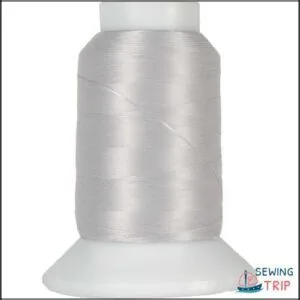
Threadart’s Silver Wooly Nylon Thread brings the stretch and softness hand sewers rarely find in machine-ready spools, designed specifically for sergers that work with knits, activewear, and anything that needs to move with the body. Thread elasticity makes it ideal for rolled hems on swimwear and lingerie, while the color vibrancy stays put through repeated washing. You’ll find 50 colors available in this nylon thread with a 200 thread size.
| Feature | Specification | Application Benefit |
|---|---|---|
| Spool Length | 1000M (1100 yds) | Extended use without frequent changes |
| Thread Elasticity | Stretchy, ravel-free | Serger applications for activewear |
| Surface Feel | Soft texture | Sensitive skin compatibility |
| Color Range | 50 available shades | Color vibrancy for creative projects |
| Edge Finishing | Rolled hems capable | Professional seam coverage |
When selecting industrial sewing threads, this option bridges the gap between industrial thread types and uses focused on comfort-driven garments.
Frequently Asked Questions (FAQs)
Which is thicker, Tex 45 or Tex 70?
Tex 70 thread weighs more than Tex 45, making it thicker. The Tex numbering system measures weight in grams per 1,000 meters of thread, so higher Tex numbers always indicate heavier, thicker threads for your project.
What are the different types of sewing thread?
Sewing thread types include cotton, polyester, nylon, rayon, and silk—each with unique thread composition suited to different projects. Specialty threads like metallic and biodegradable threads expand your thread alternatives, while thread innovations deliver better thread construction for industrial thread and general sewing thread materials.
Which is heavier, 40 wt or 50 wt thread?
Weight comparison reveals counterintuitive thread numbering systems: 40 wt thread is heavier than 50 wt thread.
Lower weight numbers mean thicker threads because thread weight measures how many kilometers of thread equal one kilogram, affecting application impact and Tex conversion directly.
What kind of thread is best for heavy fabrics?
Heavy Duty Thread works best for thick materials because it withstands high seam stress. You’ll want bonded nylon or polyester with higher thread strength to match your fabric type. Pair it with the right needle size for proper stitch density in heavyduty sewing projects.
What factors determine optimal thread tension settings?
Fabric thickness and thread type interact with needle size and machine speed to shape tension adjustments. Thread elongation affects seam performance, while stitch length influences how thread properties respond under stress, requiring precise tension calibration.
How do you prevent thread breakage during production?
Thread breakage during production stems from poor needle selection, incorrect thread tension, and material compatibility issues.
Operator training on machine maintenance and understanding thread properties and performance factors helps prevent industrial sewing thread failures before they disrupt your workflow.
What maintenance extends industrial sewing thread lifespan?
Think of thread as a living material—it breathes, ages, and reacts to its environment.
Thread isn’t static—it breathes, ages, and reacts to its environment like any living material
Store your thread in cool, dry spaces with humidity control to prevent degradation. Shield spools from UV exposure and UV rays, clean machines regularly, and apply proper lubrication practices to maintain thread properties and water resistance over time.
Can different thread types be used together?
Mixing thread types can compromise seam integrity and performance. Different thread materials, construction methods, and properties create blending risks, affecting tension balance and durability.
For aesthetic considerations and consistent results, match thread selection throughout your project.
How does humidity affect thread performance characteristics?
Humidity affects thread performance by increasing moisture absorption, which weakens strength and promotes fungal growth. Storage conditions matter—high humidity degrades lubricant impact and alters thread properties. You’ll see the biggest changes in natural fibers like cotton and rayon.
Conclusion
Here’s the irony: you can master every detail about industrial sewing thread types—tensile strength charts, tex calculations, fiber construction methods—yet still choose the wrong spool if you ignore what your fabric actually endures. Thread selection isn’t about memorizing specifications; it’s about matching material reality to operational stress.
A sailmaker who picks bonded nylon for its UV resistance understands this. So does the upholsterer who tests stretch before committing to a production run. Knowledge matters, but application determines whether seams hold or fail.
- https://blog.collinsdictionary.com/cefr-labels-explained/
- https://www.qualitythread.com/blogs/news/applications-for-bonded-nylon-thread-a-versatile-solution-for-various-industries
- https://www.mh-chine.com/blog/products/69-bonded-nylon-polyester-thread
- https://www.maggieframes.com/blogs/embroidery-blogs/bonded-nylon-thread-69-ultimate-guide-for-machine-embroidery
- https://www.techsew.com/us/blog/nylon-thread-buying-guide.html

